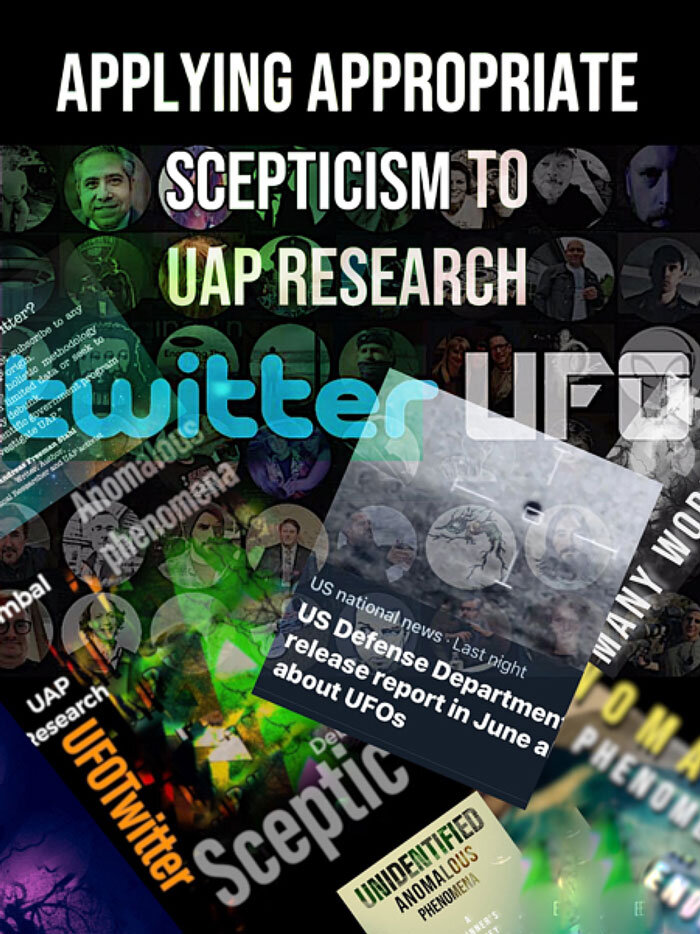APPLYING APPROPRIATE SCEPTICISM TO UFO RESEARCH
ADOPTING A SCEPTICAL approach to research is incredibly important. Whether that’s critically assessing a Pentagon UAP video or the testimony of a navy pilot, it is important to objectively evaluate data from a holistic methodological approach. However, it is also imperative to consider that being sceptical must apply to your own thinking, ideologies, hypothesis and conclusions. Essentially, you aren’t trying to prove something, you are trying to find objective truth, not your version of it. As my old professor of clinical psychology once told us – ‘you should be just as sceptically minded with your own hypothesis, if not more so, than that of others’.
And she was exactly right. The aim of professional research isn’t to start with a conclusion and work backwards to reach a predetermined, desired result, the aim is to not even care what the end result is and let the holistic data lead you wherever it leads you. Your hypothesis comes second.
This is how science works.
If Ufology is to become more than fringe, it needs move past the unscientific processes, the speculation dressed up as factual conclusions, the knee-jerk pre-debunking that instantly dismiss cases with ridiculous explanations, and the conmen believers selling extra-terrestrials for profit. We need to abolish the believer vs debunker ideologies and move into science.
Being sceptical is a representation of that scientific process, not a means to forge subjective narratives. Unfortunately, the field of Ufology (study of UFOs) has been heavily dogmatic in its approach, criticised by the scientific community and labelled as fringe for too long. This is primarily due to the ways in which UFO researchers approach data from the perspective of believing that ‘UFOs’ by absolute definition are extra-terrestrials. And this critical issue comes through mainstream media and the public sphere itself and is abundantly obvious when the topic comes up in mainstream media.
Believers of the extra-terrestrial hypothesis are a problem to the scientific process. They have already established a conclusion and are working backwards to ensure case data fits their narrative. Sadly, this is not contained to Ufology. The general public believe that UFOs are either ‘aliens’ or they are terrestrial misidentifications – there is no middle ground and zero appreciation or application of a clinical, holistic approach to analytical data evaluation.
Any introduction of an alternative, more complex theory to explain the anomalous is often neglected in favour of a psychologically accepted explanation that has foundations from within a social community. A social paradigm which holds objective truth second to subjective needs.
Very little of UAP study within Ufology has basis in scientific knowledge or any valid approach that evaluates and critically assesses new data that may challenge the current ideological paradigm.

Now this is not to say that some UAP might indeed be extra-terrestrials and given the extreme (AATIP five observables) abilities displayed by these vehicles, it is not outrageous to consider a non-human origin as a hypothesis (not conclusion). However, to assume because something anomalous might be non-human does not automatically assign the origin as ‘aliens’ coming from another planet.
Over the last year, the ideologies for UAP explanations have ranged from extra-terrestrials, ultra-terrestrials, inter-dimensional, time-travellers, multi-verse travellers and even a product of human consciousness. Most interesting, is the concept that the anomalous is a quantum anomalous phenomenon, that brings into question the function and origin of such an ‘alien’ consciousness. None of the above are considered by debunkers or believers.
But how do we assess these hypotheses given that the government won’t release critical UAP data – add to this that Ufology can’t apply an appropriate scientific research methodology and that the biased scientific community refuses to accept that UAP are even real.
What is needed, would be a rigorous scientific methodology that appropriately assesses UAP data and formulates a hypothesis which can be tested and then retested. Should that hypothesis not be testable due to lack of correlating data? Then we shouldn’t be afraid to say that is the case, or simply, ‘we don’t know.’
For me, this is why scepticism is vitally important.
Just because I consider that UAP might have the potential to be anomalous phenomena - some non-human intelligence/technology that originates from an unidentified origin - doesn’t mean we should assume that as fact, and it doesn’t mean we should conclude on limited data. The scientific process should welcome a ‘we don’t know,’ scenario, as opposed to assigning a ‘best guess’ and then dismiss approach.
The other unfortunate aspect of UAP research, which is just as problematic, is the pseudo-sceptics or debunkers.
You know exactly who these people are. Historically, these are people who hide under the guise of a scientific process but in reality are desperately trying to find ways to explain and dismiss UAP case reports. Such groups have over the years, proposed outlandish conclusions based on little to no data, often taking fractions of a blurry video and building a narrative.
Pseudo-claimants have advocated terrestrial explanations that ignore holistic case data - from system glitches, bokeh, weather balloons, flares, swamp gas, Venus, seagulls and any other explanation that simply dismiss what was reported by multiple military and civilian witnesses. In some unfortunate cases, data has been manipulated by both believers and debunkers to show a specific outcome.
Naturally, this is not acceptable and is opposed to the scientific process for finding objective truth. Such people have no place in UAP research.
Over the past year, one of the worst (almost conspiratorial) YouTube claims came for the ‘Go Fast’ UAP video. This claim stated that the unidentified object in the military video was a slow-moving balloon – that somehow the United States military can’t identify rogue balloons that enter the airspace of nuclear strike groups.
Which is ridiculous.
The conspiracy claim further proposed that somehow, this short, blurry, UAP video (and others) were apparently used to fraudulently convince a naïve congressional oversight committee into establishing a UAP task force.
Which is again, ridiculous.
Similar themes emerged for ‘FLIR1’ video, that the ‘Tic-Tac’ UAP was a seagull, and the ‘Flying Disc’ of ‘Gimbal’ was a lens glare – despite pilots stating exactly what happened in each case. But still debunkers ignored their testimony in favour of their own narrative.
These are individuals who are similar to believers in approach, they adopt the exact same poorly placed methodological process of attempting to start investigations with an already decided upon conclusion and work backwards. In the case of the debunker or pseudo-sceptic, it’s that all UAP have a terrestrial origin, and quite often you will find they will assign any explanation to the case, so long as it doesn’t conclude ‘aliens’ and so long as the case is not left unexplained.
Another issue is that the debunkers will also attempt to deviously label ‘UFOs’ as extra-terrestrials themselves as part of a ‘straw man’ argument, thus, framing the entire conversation of debate away from the fact something is in the skies which needs official investigation. And even worse, believers fall for it every time, they play the debunkers game, a game that’s rigged from the start. After all, how does one prove UFOs are extra-terrestrial in origin without hard tangible proof? Without an ‘alien’ on a podium, bodies in pickled jars or keys to the hanger doors buried deep in the desert it becomes a difficult task for even the most well connected member of the Mellon family.
Additionally, what would constitute that proof beyond a reasonable doubt to the world? We don’t have deep space tracking on UAP on radar as they leave orbit, and then tracking said vehicles for light years across outer space is surely impossible. Even if Roswell wasn’t a Mogul balloon, and if the crashed Roswell bodies were non-human, and then even if somehow, we had access to them, that still doesn’t equate to them being from another planet. Much more data is needed before we even begin to arrive at such a conclusion.
All of this plays into the debunker and believers’ endless cycle of trying to prove and disprove a hypothetical conclusion which ignores the fact that something real and unidentified is in our skies. An endless game of cat and mouse.
The third problem group we can identify, is the scientific community – particularly the astronomers. Across 2018, and going back decades, we have very well received voices such as Carl Sagan and others who have been the champion of denouncing ‘UFOs’ and the associated technology. Take for example, SETI – the Search for Extra-terrestrial Intelligence, who are heralded as pioneers within their field and filled with beautifully brilliant minds. This historically well-funded group of scientists and astronomers have chased down the possibility of life on alien planets by using radar signals and listening to the cosmos, whilst at the same time ignoring witnesses to UFO encounters.
I’ve found that such individuals within reputable positions uphold a strong subjective position to UAP, automatically assuming (without evidence) that the argument basis is for extra-terrestrials, and then look to address the fallacy of that position based on linear-thrust propulsion of chemical rockets for interstellar travel. Distance, mass, energy, time, etc. All valid points to impose on our own 21st century technology, but, who are we to impose our limitations on others, potentially races that are more advanced?
What SETI and others haven’t done, unfortunately, is to then provide alternative and better fitting possible hypotheses for ‘non-human’ intelligences here in our skies.
The theories of anomalous are left to amateurs such as myself and my colleagues at UAPMedia to take wild stabs at. This is a problem.
Modern science, as brilliant as it is, has one major flaw - the fallacy of human’s inability to incorporate him/herself into the observer equation. And this is no more evident, than with UAP technology. As a scientific community, they were unable to holistically interpret the ‘UFO’ data, because they didn’t look at it, their clinical judgment critically affected prior to observation, thanks to the psychology of stigma. And it was these self-reflective limitations which prevent the scientist from objectively assessing the information and processing it. Obviously, not in a way which tries to specifically prove or disprove the extra-terrestrial hypothesis, but in a way which looks at the radical UAP technology and concludes more data and official investigation is needed.
I’ve also found that, the higher the public position held, and the higher self-esteem held by the scientist, the more pushback they display against UAP investigations. We found this time and time again across 2018 through speaking to scientists and monitoring their reactions to UAP news and published articles.
For some unknown reason, an astronomer gets quoted in mainstream UAP articles rather than a physicist, or a defense contractor or an aerospace engineer. The astronomer is expected to make comment because the uneducated counter-assumption for UAP is extra-terrestrial, which then needs to be debunked by the astronomer and journalist in an unwitting combined effort.
Consider also, the social attitude towards the scientist is in high regard, whereas the social attitude towards the ‘UFO believer’ is low. As a ‘UFO person’ I have first hand experience of this.
Now consider the idea that the ‘tin-foil hat’ wearing crazy conspiracy theorist was right and the high-ranking scientist in the public eye was wrong. Wrong about the most important issue in history.
Such a scenario would produce significant cognitive dissonance for the scientist and might therefore explain their strong negative pushback to UAP investigations. Then you might configure into the equation the subconscious foresight of potential issues over reputation and threats to government funding. Not something they would want to advocate.
In light of these problem groups, what we need to do is to stop concluding on limited data. Certainly, hypothesise about UAP origin, but then work forwards in your research, not backwards and most importantly, work to disprove your own conclusions before others do it for you.
We need a better class of believer and sceptic if we are to solve this UAP mystery.

